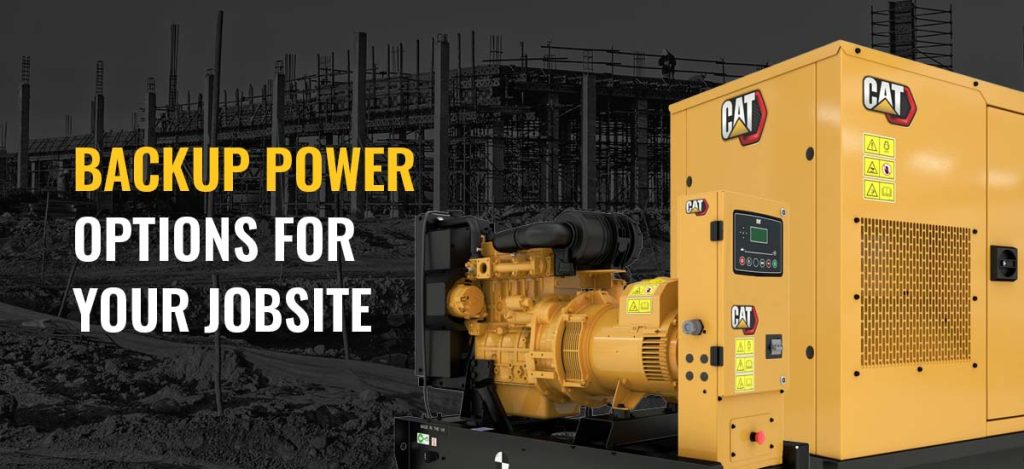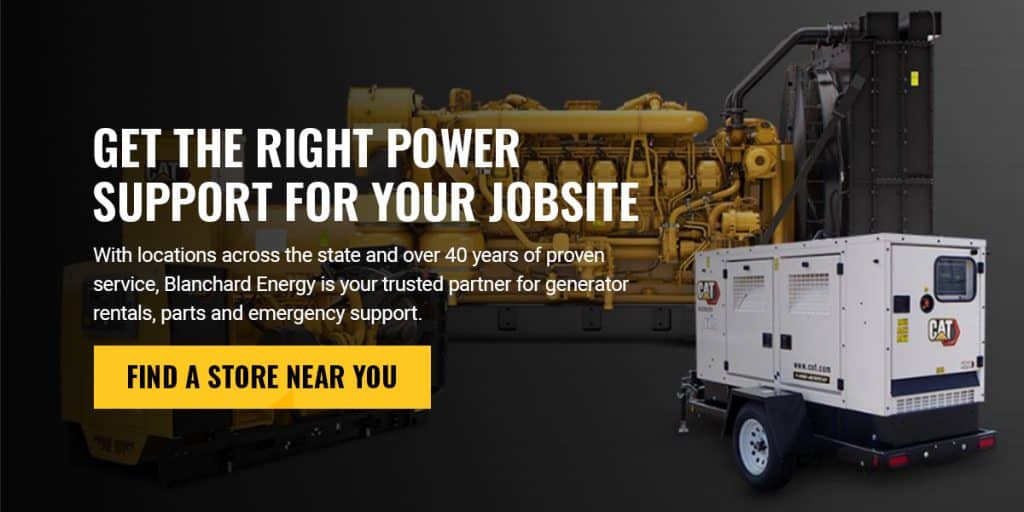
Join the Blanchard Team..
Apply Now

When the power goes out on a jobsite, everything comes to a halt. Lights go dark, tools stop running and your crew loses valuable time. Extended outages can become expensive delays that affect your operation’s reputation and progress. Having a reliable backup plan in place is just as important as the equipment you use.
Let’s walk through how to power a jobsite and how you can choose the right equipment for your team.
Most construction sites lack a permanent power connection. Brand-new construction, demolition and other projects are temporary setups for your equipment, which means bringing in power during the work. While equipment often has batteries and fuel, construction teams still need power to weld, run lights, lift and communicate. Temporary offices and safety systems also require power solutions. Knowing what to do when the power goes out at a jobsite prevents safety issues and extended project timelines.
Once you’re up and running, there is still a risk of an outage. Grid strain, heat waves and even extreme weather can suddenly take out your site’s power. Even a single lost day can cost you. Backup power is there to keep your operation moving during surprises.
No two construction jobs run the same. You need to find a power solution that fits your project, fleet size, team and duration. Towable, diesel and gas generators are all options, along with mobile solar panels. Once you’ve calculated your load demand and timeline, you can explore temporary power equipment.
These are the go-to options for jobsites that need reliable, portable power on demand. Just mount towable generators on trailers and move them wherever they’re needed. They come in a wide range of sizes for all load demands. Look at compact units for lighter loads and high-capacity models for multiple power zones. Many also feature sound-attenuated enclosures, making them a great fit for urban projects or sites with strict noise requirements.
Towable generators are one of the most convenient, flexible options available. You can bring in one large unit for the full site or mix and match several smaller ones to cover different areas. They’re ideal for contractors who want to scale their power with each project.
Sites that need constant, high power levels should consider diesel generators. These models are built for longevity and high output, making them critical in remote locations. Additionally, they can run for long stretches on a single tank, reducing the need for fuel trips and storage.
If your priority is fuel convenience or quieter operation, explore gas generators. Natural gas or propane provides reliable power without the noise of a diesel generator. Make sure your team has proper ventilation and a plan for fuel delivery or line access on-site.
Mobile solar panels and battery storage systems are more sustainable backup power solutions. They can’t replace towable, diesel and gas generators completely, but they can power low-demand systems like lights and chargers. Solar works best in sunny regions — combine mobile solar power with your main generator to maximize sustainability and power.
Choosing backup power goes beyond fuel preferences. You must know how much power you need. Undersized generators lead to tripped breakers and equipment issues. Oversized units mean excessive fuel spending and additional storage space. Find a generator that balances load and expenses to match your power needs.
Here are some tips for finding your power sweet spot:

Even with detailed planning, there are always surprises. Working with an experienced power supplier helps ensure you aren’t guessing at backup power support. An expert team can evaluate your jobsite, review load needs and help you choose the right generator setup. This approach saves you time and money when you’re working on-site.
Once you’ve looked at generators and calculated power, the next step is to provide power safely and efficiently. The right plan protects your generator, team and jobsite from power issues.
Support backup systems with spider boxes, switchgear and cables. Spider boxes or power distribution boxes break down power into usable outlets across the site. Switchgear manages load and gives you control over where and how you deliver power. Finally, you need heavy-duty, weather-rated cables to keep power moving in all conditions.
Layout affects power delivery and safety. Place generators on stable ground, away from high-traffic areas but close enough to shorten cable runs. Keep distribution points under cover and elevated to avoid standing water.
Safety is nonnegotiable. Always use ground fault circuit interrupter (GFCI) protection to prevent shock hazards. You also need to ensure all outlets and boxes are weatherproof, especially in volatile climates. Another important safety measure is load balancing. Circuits need even power distribution to avoid overheating and shutdowns. Finally, place all cords outside of equipment paths and mark them to avoid cutting the power.
All generators and power solutions must follow OSHA regulations and local electrical codes. These requirements will establish proper grounding, spacing and inspection periods for your equipment and power sources. Failure to follow these regulations can lead to safety hazards and fines.

From high-demand commercial projects to rural infrastructure builds, every construction site needs backup power. Blanchard Energy has the backup power solutions you need to stay on track. We offer backup and temporary power equipment and services tailored to South Carolina contractors. Our experts are here to help you with sizing, equipment use and repairs.
With locations across the state and over 40 years of proven service, Blanchard Energy is your trusted partner for generator rentals, parts and emergency support. Let’s keep your site powered up and productive in all conditions. Reach out to us for help with sizing and selecting your next power solution.